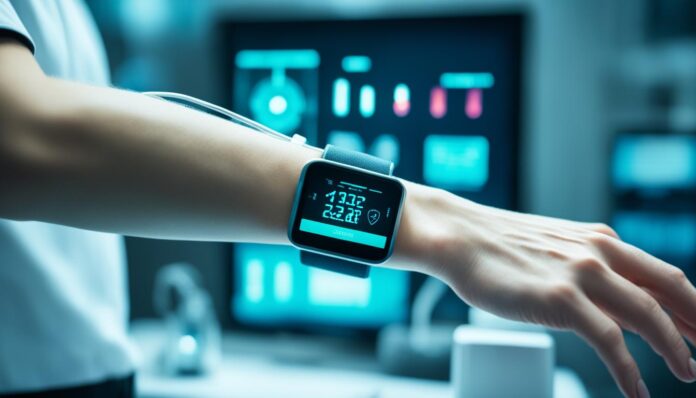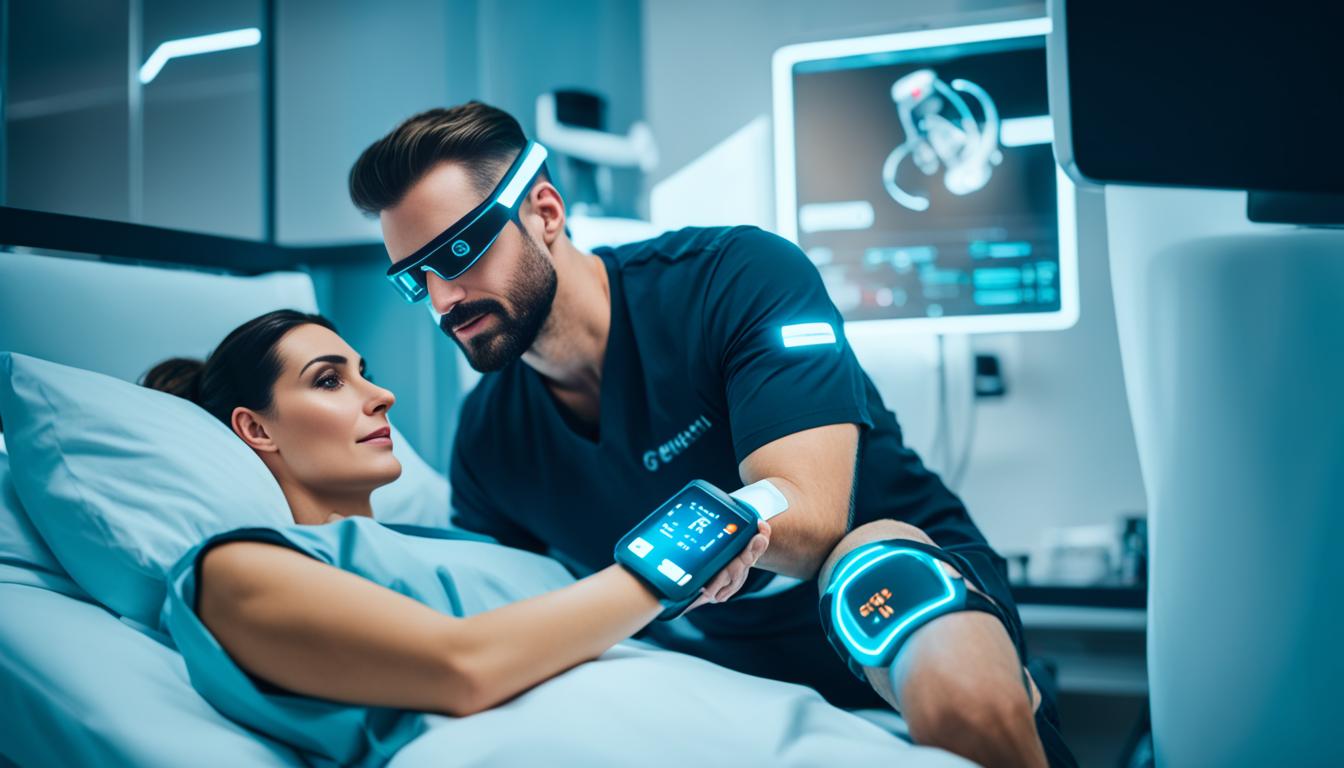
Healthcare and technology have become inseparable, working hand-in-hand to deliver better care to patients worldwide. The ongoing COVID-19 pandemic and advancements in artificial intelligence (AI) are top drivers encouraging healthcare organizations to adopt Internet of Things (IoT) medical devices. In fact, last year, around 87% of healthcare organizations had already integrated IoT technology. By 2025, experts predict the wearable technology market will reach a staggering $74.03 billion, a significant increase from its $27.91 billion valuation in 2019. Simply put, a medical device is any instrument, apparatus, implement, appliance, machine, implant, in vitro reagent or calibrator, material, software, or another similar or related article used for monitoring, supporting, control, and provision of health. The Internet of Things refers to the use of electronic devices that acquire or monitor data and are connected to either public or private networks, enabling them to initiate certain actions.
Key Takeaways
- The adoption of wearable health tech is expected to significantly transform healthcare by 2025, driven by the COVID-19 pandemic and advancements in AI.
- The wearable technology market is projected to reach $74.03 billion by 2025, up from $27.91 billion in 2019.
- IoT medical devices have been rapidly integrated by healthcare organizations, with around 87% of them adopting the technology last year.
- Wearable devices can serve various healthcare functions, including monitoring, supporting, control, and provision of health.
- The Internet of Things enables the use of electronic devices that acquire or monitor data and are connected to networks, allowing them to initiate actions.
Wearable Health Tech: From Novelty to Standard Practice
The adoption of wearable health tech, including remote patient monitoring and telehealth technologies, has accelerated in recent years, driven by the COVID-19 pandemic and regulatory changes by the FDA. These advancements have integrated Internet of Things (IoT) capabilities into medical devices, revolutionizing healthcare delivery and patient care.
Accelerated Adoption Due to COVID-19
Since March 2020, the COVID-19 pandemic has radically transformed the landscape of remote patient monitoring. In just 3 months, this technology transitioned from a fringe concept to a mainstream necessity, as healthcare providers sought ways to monitor patients without in-person visits. In response, the FDA implemented temporary regulations to facilitate the use of non-invasive remote monitoring devices and introduced new payment codes for telehealth services. On August 3, 2020, President Donald Trump signed an Executive Order that further expanded access to telehealth beyond the current public health emergency.
FDA Regulation Changes to Facilitate Adoption
The FDA issued guidance titled “Enforcement Policy for Non-Invasive Remote Monitoring Devices Used to Support Patient Monitoring During the Coronavirus Disease 2019 (COVID-19) Public Health Emergency (Revised)” on March 20, 2020. This policy aims to expand the availability and capabilities of non-invasive remote monitoring devices to facilitate patient monitoring while reducing exposure to COVID-19 for the duration of the public health emergency.
Integrating IoT into Medical Devices
Before the era of IoT, doctor-patient interactions were limited to physical visits, telephone, and text communication, restricting the ability to monitor patient health and provide timely treatments. The introduction of IoT in healthcare has revolutionized patient care, making it more accessible. Advancements in technology, data analytics, and increased competition have driven the growth of healthcare IoT and IoT medical devices, enabling remote patient monitoring and telehealth services. However, adoption by healthcare providers was initially slow due to concerns about data quality, liability, and interoperability. The COVID-19 crisis has since made the value of remote patient monitoring widely recognized, leading to its mainstream adoption.
How will the adoption of wearable health tech change healthcare by 2025?
Remote Patient Monitoring and Telehealth
Most IoT in healthcare is centered around improving patient care through remote monitoring and telemonitoring, which applies as the main application in the broader scope of telemedicine. A secondary area with many initiatives includes tracking, monitoring, and maintenance of assets, using IoT sensors. This is utilized on the level of medical devices and healthcare assets, the patient level, and the non-medical asset level (e.g. hospital/clinic building assets). There is a vast landscape of healthcare stakeholders and possibilities with IoT healthcare projects, including personal healthcare, healthcare insurance, the pharmaceutical industry, RTHS, healthcare building facilities, smart beds, robotics, biosensors, smart pills, anything remote, and the various medical specializations, activities and even disease treatment – the possibilities are endless both for the healthcare industry and device designers/manufacturers.
Preventative Healthcare and Chronic Disease Management
The rise of technology and consumer-centric healthcare is shaking up patients’ demands at every stage of the healthcare journey. They expect more frequent and preventive care, with instant updates on their health. As a result, healthcare companies are investing in wearable technology devices that integrate real-time monitoring of high-risk patients for early detection of critical health incidents. Adopting connected devices allows healthcare professionals to monitor and communicate with patients remotely, enabling the delivery of various aspects of care from any distance. Noteworthy wearable devices include blood pressure monitors, glucose meters, ECG monitors, fitness trackers, and integrated activewear. By 2024, a range of wearables will enter the market as healthcare consumers increasingly embrace health tracking and prioritize preventive well-being rather than later chronic care. Industry experts expect this shift to open the front door toward a promising era of virtual-based hospitals.
Improved Patient Engagement and Adherence
Wearable technology has been adopted in various fields in recent years. However, its most tremendous potential in healthcare applications is to address soaring healthcare costs, the rise in the geriatric population, and the burden of chronic diseases. In the healthcare field, wearable technology is defined as a non-invasive and autonomous device, which can analyze, record, and aggregate physiological data to improve personal health and well-being. Until now, wearable devices have been used for fitness motives due to increasing consumers’ expectations to monitor their health. The wearables industry is expected to balloon to a whopping USD 1,03,246.29 million by 2029. Recent technical advances provide value count for wearable healthcare, spotlighting diagnosis, monitoring, treatment, and prevention. These advantages are recognized through the entire healthcare value chain of wearables with benefits such as early diagnosis, personalization, information libraries, remote patient monitoring (RPM), medication adherence, and better decision making, with reduced healthcare costs.

Key Players and Innovations in Wearable Health Tech
The wearable healthcare devices market is thriving, encompassing a diverse range of products including smartwatches, activity monitors/trackers, hearables, smart clothing, and skin patches. In the smartwatch segment, industry leaders such as Apple, Fitbit (Alphabet Inc.), Garmin, Samsung, Xiaomi, and Omron are at the forefront. For hearables, prominent players include Apple, Huawei, Google, Sony, Samsung, Bose, Jabra, LifeBeam, and Vinci. When it comes to fitness trackers, Alphabet Inc., Microsoft, Samsung, iHealth, and AliveCor are among the key players driving innovation.
Wearable Devices in Clinical Trials
Pharmaceutical and medical device companies recognize the immense value that wearables can bring to the clinical trial process. These devices create opportunities to generate and leverage large data sets, providing valuable insights into treatment, health monitoring, and efficacy. Wearables have various applications in clinical trials, from the early detection of adverse events to tracking quality of life. Leveraging advanced analytics and AI, wearable data can unveil effects that might have gone unnoticed previously. Additionally, wearable clinical trial experiences can reduce the duration and frequency of in-person clinic visits for participants. The integration of wearables in clinical trials promises to improve the effectiveness of the process and generate deeper insights. Moreover, the FDA-approved status of traditional fitness trackers has made wearable use in clinical trials more accessible, particularly for patients.
Government Initiatives and Investments
Governments around the world are recognizing the transformative potential of wearable health tech and are actively supporting its adoption through various initiatives and investments. For instance, the tracking and data aggregation capabilities of smartwatches, such as the Apple Watch, can benefit government agencies in quickly collecting and analyzing healthcare data from the field. The state of Utah has even implemented a Google Glass app that provides real-time public transit information to users wearing the device, showcasing the diverse applications of wearable technology.
Looking ahead, there will be a proliferation of apps and solutions that connect citizens and governments, strengthening communities and enhancing public services. Furthermore, government funding, investments, and other initiatives are crucial in boosting consumer adoption of wearable healthcare devices. The Canadian government plans to invest up to USD 950 million within the Innovation Superclusters Initiative, while India’s Digital India program aims to transform the country into a digitally empowered society, with a remarkable rise in smartphone subscribers from 270 million in 2016 to an estimated 890 million by 2022. These government-backed efforts will help emerging markets like China, Japan, and India become global hubs for the manufacturing of wearable tech, including smartwatches, fitness trackers, drones, AR/VR, and Internet of Things (IoT) products.
Conclusion
The wearable technology market has truly blossomed, with over 4,000 startups manufacturing an array of devices for fitness tracking, sleep monitoring, mental wellness, and posture correction. With a staggering $18.1 billion in funding across 1,700+ companies, this sector has become a dynamic powerhouse for investors. In fact, a remarkable one-third of this funding has been raised in just the past three years.
Leading investors such as Plug and Play Tech Center, HAX, MassChallenge, Startupbootcamp, and Techstars have been actively backing this thriving industry. From diabetes monitoring devices and smartwatches to smart glasses and fitness trackers, the demand for these innovative wearables continues to surge, especially in the burgeoning Asian market.
The global medical device landscape, spanning from mass-market glucose monitors to high-end diagnostic imaging equipment, has now been joined by a new wave of wearable innovators. U.S. giants like Fitbit and Jawbone, Spain’s Nuubo, China’s Xiaomi, and Japan’s Omron are all vying for a share of this rapidly expanding market. As you can see, the future of healthcare is undoubtedly connected, and wearable technology is leading the charge.
FAQ
What is the current adoption rate of IoT technology in the healthcare industry?
Last year, around 87% of healthcare organizations have adopted IoT technology.
How will the wearable technology market grow by 2025?
By 2025, experts predicted that the wearable technology market will reach .03 billion, a significant increase from its valuation in 2019 of .91 billion.
How has the COVID-19 pandemic influenced the adoption of remote monitoring technology?
Since March, there has been a radical change in remote monitoring influenced by the Covid-19 pandemic. In merely 3 months, remote monitoring went from fringe technology to mainstream due to the need to monitor patients without a physical visit to a doctor or hospital.
How has the FDA responded to the increased use of remote monitoring devices during the COVID-19 pandemic?
The FDA implemented temporary regulations aiding the use of these devices, and two new payment codes were put in place for remote monitoring.
What are the main applications of IoT in healthcare?
Most IoT in healthcare is centered around improving patient care through remote monitoring and telemonitoring, and tracking, monitoring, and maintenance of medical devices and healthcare assets.
How are wearable devices transforming the healthcare industry?
Wearable technology is being adopted to address soaring healthcare costs, the rise in the geriatric population, and the burden of chronic diseases. Wearables provide value through early diagnosis, personalization, remote patient monitoring, medication adherence, and better decision making, with reduced healthcare costs.
What are some of the key players and innovations in the wearable health tech market?
The leaders in the wearable health tech market include Apple, Fitbit (Alphabet Inc.), Garmin, Samsung, Xiaomi, Omron, Huawei, Google, Sony, Bose, Jabra, LifeBeam, and Vinci. Wearables are also being used in clinical trials to generate and leverage large amounts of data sets, providing insights into treatment, health monitoring, and efficacy.
How are governments supporting the adoption of wearable healthcare devices?
Government support through funding, investments, and other initiatives boost consumers’ adoption of wearable healthcare devices. For instance, the government of Canada is expected to invest up to USD 950 million within the Innovation Superclusters Initiative, and the Digital India initiative aims to transform India into a digitally empowered one.
